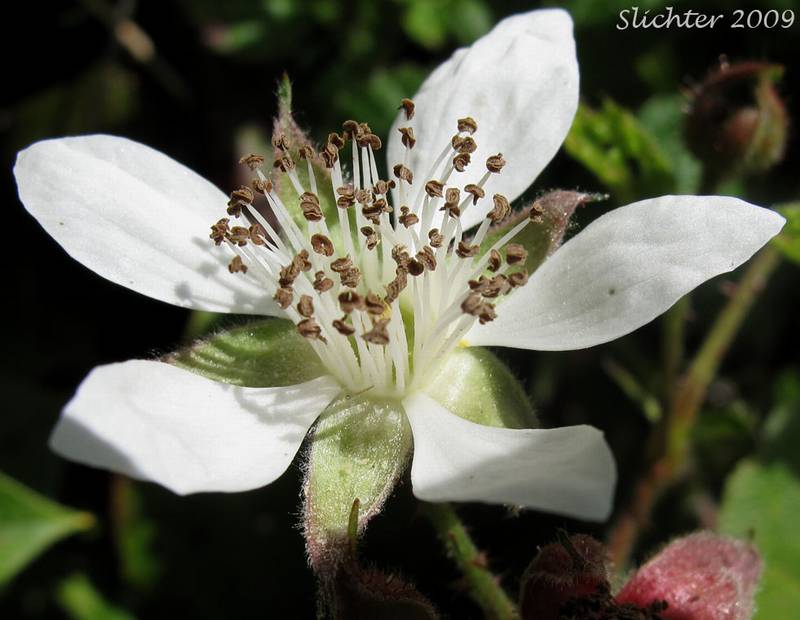Rubus ursinus
Rubus vestitus
Pacific blackberry, trailing blackberry, dewberry, Douglasberry
European blackberry
Leaves trifoliate, the lateral leaflets ovate-lanceolate, 3-7 cm. long, doubly serrate;
terminal leaflet larger, deeply 3-lobed.
Leaves alternate, partially evergreen, 3- to 5-foliate;
stipules lanceolate, 5-10 mm. long;
leaflets ovate to rotund-ovate, acuminate, 5-10 cm. long, doubly serrate, green and glabrous above, paler and pubescent beneath.
Floral branches several, 1-3 dm. long, erect, bearing several leaves and 1-several flat-topped flower clusters, the inflorescence with stalked glands;
calyx hairy and glandular, the 5 lobes lanceolate, 5-11 mm. long; staminate petals 5, white, elliptic-spatulate, 7-11 mm. long, with 75-100 stamens; pistillate petals broader and shorter, with numerous pistils.
Flowers numerous in flat-topped panicles, hairy and stipitate-glandular;
calyx white-woolly, the 5 lobes reflexed, lanceolate, acuminate, up to 1 cm. long;
petals 5, white, pinkish tinged, 10-15 mm. long;
stamens at least 75;
pistils numerous, styles glabrous.
Drupelets purplish-black, coherent, attached to the elongate receptacle;
fruit up to 2.5 cm. long.
Drupelets coherent, and with the receptacle forming a globular blackberry about 1.5 cm. thick.
Rubus ursinus
Rubus vestitus
- Local floras:
BC,
CA,
OR,
WA
- Local Web sites:
CalFlora,
CalPhotos,
Flora NW,
PNW Herbaria,
Turner Photog.
WildflowerSearch
iNaturalist (observations)
USDA Plants Database
- LBJ Wildflower Center
- SEINet
- Plants of the World Online
- Encyclopedia of Life
- Wikipedia
- Google Image Search
- Local floras:
BC,
OR,
WA
- Local Web sites:
Flora NW,
PNW Herbaria
WildflowerSearch
iNaturalist (observations)
USDA Plants Database
- LBJ Wildflower Center
- SEINet
- Plants of the World Online
- Encyclopedia of Life
- Wikipedia
- Google Image Search



